Intriguingly, a considerable number of individuals rely on replacement teeth to rekindle their smiles. Many among us necessitate tooth replacements due to factors such as decay, injury, infection, or other dental issues. A missing tooth might elicit embarrassment, but the good news is that numerous avenues exist for restoring your radiant smile.
While the task of replacing a lost tooth is intricate, dental implants present a remarkable solution for reinstating your smile. Boasting a remarkably natural appearance that blends seamlessly, these implants also play a pivotal role in preserving and safeguarding your oral health over the long term. To decipher the ideal dental implant choice, peruse the following discourse to gain insights into the diverse implant types and materials available.
Navigating the Ideal Candidate for Dental Implants
Replacement teeth offer an exceptional remedy for individuals contending with tooth loss stemming from trauma or periodontal ailments. For those contemplating dental implants, it remains imperative to ascertain their eligibility. To this end, the following prerequisites must be met:
- Maintain impeccable oral health
- Ensure that the jaw exhibits sufficient bone density for implant stability
- Uphold commendable oral hygiene practices
- Foster the health of gum tissue
Exploring the Array of Dental Implant Types
Intriguingly, dental implants unfold as the epitome of a natural, enduring solution catering to varied oral health needs. Within this realm, two distinct implant types, namely endosteal and subperiosteal, stand out, accompanied by two procedural approaches – the single-stage and two-stage methods. Although your dentist is best positioned to recommend the most fitting option, comprehending their nuances remains invaluable.
Endosteal Implants: A Paradigm of Durability and Form
Endosteal implants take center stage as dentists’ preferred route for replacing missing teeth. These implants offer a dual benefit – not only do they establish a sturdy and enduring foundation, but they also maintain the facial and jawbone contours.
Functioning akin to synthetic tooth roots, these implants are affixed into the jawbone, providing robust support and thwarting bone deterioration, teeth misalignment, and the displacement of neighboring teeth that might arise in the absence of an implant.
Subperiosteal Implants: An Alternative of Aesthetic Excellence
Subperiosteal implants extend a captivating alternative to those grappling with weakened or compromised jawbones. In contrast to their endosteal counterparts, these implants are situated beneath the gum tissue or atop the jawbone, yielding a similar aesthetic.
Patients who opt for this implant variation can revel in a secure and steadfast outcome, irrespective of the condition of their jawbone. Dentists may recommend bone augmentation to reinforce and rejuvenate patients’ jawbones for eventual endosteal implantation. However, for those seeking to circumvent this procedure, subperiosteal implants provide a comparable solution.
Embarking on Dental Implant Procedures
Single Stage: Streamlined and Beneficial
The single-stage dental implant procedure presents a streamlined surgical intervention. The dentist conducts a straightforward surgical procedure to embed a longer dental implant within the jaw and gums, exposing the implant’s upper part. Upon the healing of the area, the connector and crown components are directly affixed to the exposed implant segment, culminating in a seamless conclusion of the process.
This approach proves particularly advantageous for patients necessitating dental implants due to bone-related issues or unique requirements. The expedited nature of the procedure, coupled with simplified adjustments for the new teeth, renders the single-stage approach highly beneficial.
Two Stage: Patience Rewarded with Resilience
Although the two-stage dental implant procedure may appear daunting initially, it unfolds with remarkable simplicity. Following the insertion of the implant base into the jawbone, a healing period spanning a few months ensues. Subsequently, a minor surgical intervention unveils the implant’s base, facilitating the attachment of the connector segment and crown.
While this procedure entails a lengthier duration compared to its single-stage counterpart, the eventual outcome undoubtedly justifies the investment. The implant’s base fosters a robust foundation between the first and second surgeries, akin to a natural tooth root, underpinning lasting advantages.
Decoding Dental Implant Materials
Traditionally, titanium implants enjoyed hegemony within the domain of implant dentistry. Yet, the realm of implant materials has expanded with technological progress, ushering in a broader selection.
Presently, both titanium and zirconia garner widespread adoption, subject to extensive research scrutinizing their chemical and physical attributes, including resistance to corrosion and fractures, in tandem with their microstructure and composition. Rigorous evaluation ensures adherence to exacting quality standards.
Titanium Dental Implants: A Legacy of Excellence
For myriad individuals, titanium dental implants retain their mantle as the preferred choice. A key advantage of these implants resides in their minimal disturbance of the surrounding jawbone. The titanium implant fosters bone growth akin to that around a natural tooth, ensuring a prolonged implant lifespan.
Titanium implants boast unparalleled strength and versatility, rendering them ideal for individuals with titanium allergies. The alloy composition engenders a harmonious union with the human body, manifesting impeccable biocompatibility. This attribute aligns the implant seamlessly with the bone, establishing titanium implants as a peerless choice.
Zirconia Dental Implants: The Contemporary Contender
The dental implant arena welcomes zirconia implants, the latest entrant in the realm of implant materials. For those apprehensive about metal allergies or the utilization of metal, zirconia implants proffer an exceptional, metal-free alternative.
Furthermore, zirconia material showcases exceptional hardness and strength, rendering it an apt selection for bridges and crowns. Mirroring the behavior of titanium, zirconia implants integrate seamlessly with the bone, guaranteeing steadfastness.
While zirconia implants may lack the historical longevity of titanium counterparts and the extensive testing, they offer two notable advantages:
- Reduced visibility of dark metal through the gums
- Enhanced corrosion resistance compared to titanium
Navigating Potential Procedure Hurdles
The resounding success of dental implants is undeniable. Occasional complications, if any, tend to be minor and easily managed by dental professionals. Some common issues reported by implant recipients encompass:
- Implant Loosening: If an implant becomes loose during the healing phase, the dentist may remove it temporarily to enable bone strengthening before implant reinstatement.
- Perimplantitis: This condition can lead to severe pain and the degradation of bone around the implant. In such instances, implant removal might be necessary, potentially followed by a bone grafting procedure to restore the area.
- Fractured or Worn Implants: In cases of implant fracture or wear, the dentist evaluates the situation and prescribes the most suitable course of action.
- Nerve Proximity: Incorrect implant placement near a nerve can cause significant nerve and tissue damage, resulting in enduring discomfort and sensation loss in the mouth.
- Rejection: The body’s response to the foreign implant can lead to rejection.
- Allergic Reactions: Individuals with allergies should be cognizant of potential reactions to implant constituents. To ensure safety and optimal outcomes, a MELISA test is advised pre-procedure.
Navigating the Dental Implant Journey
Pre-Procedure Preparations
Prior to embarking on the dental implant journey, pivotal steps must be undertaken:
- Comprehensive Dental Examination
- Development of a Surgical Plan
- Disclosure of Medical Conditions and Medications
- Discussion of Pain Management Options
- Surgery Scheduling
Implantation Procedure
Surgical anesthesia might induce drowsiness. The implantation involves incisions in the gums, which can lead to bruising, swelling, minor bleeding, and discomfort. Pain relief medication may be prescribed to alleviate discomfort.
After the procedure, the gums are expertly sutured to conceal the implant. Several months later, the second phase takes place, allowing for gum healing. Subsequently, an artificial tooth is securely attached to the implant.
Pre-Care Imperatives
Adherence to pre-care guidelines is vital before undergoing a dental implant procedure:
- Abstain from alcohol and tobacco consumption two weeks prior to surgery to mitigate potential complications and enhance healing.
- Inform your doctor of your medication regimen to preempt potential risks.
- Prioritize oral hygiene to reduce post-surgery bacterial infections.
- Arrange safe transportation to and from the hospital.
- Assemble essential recovery supplies.
Post-Procedure Recommendations
- Manage discomfort with over-the-counter pain relievers.
- Alternate ice application for the initial 24 hours to alleviate inflammation.
- Consume prescribed antibiotics for infection prevention.
- Opt for soft foods for a few days.
- Steer clear of hot and spicy foods and drinks.
- Maintain meticulous oral hygiene.
- Avoid vigorous exercise.
- Abstain from smoking for two weeks.
- Refrain from biting hard substances.
- Attend post-procedure dental check-ups.
Unveiling the Beauty of Dental Implants
The realm of dental implants unfolds as a gateway to reinstating not just smiles but also oral health and confidence. By embracing the possibilities offered by different implant types and materials, individuals can unlock enduring benefits while navigating potential complications with informed understanding. Ultimately, the path to a revitalized smile is paved with meticulous care, professional guidance, and the transformative magic of dental implants.




